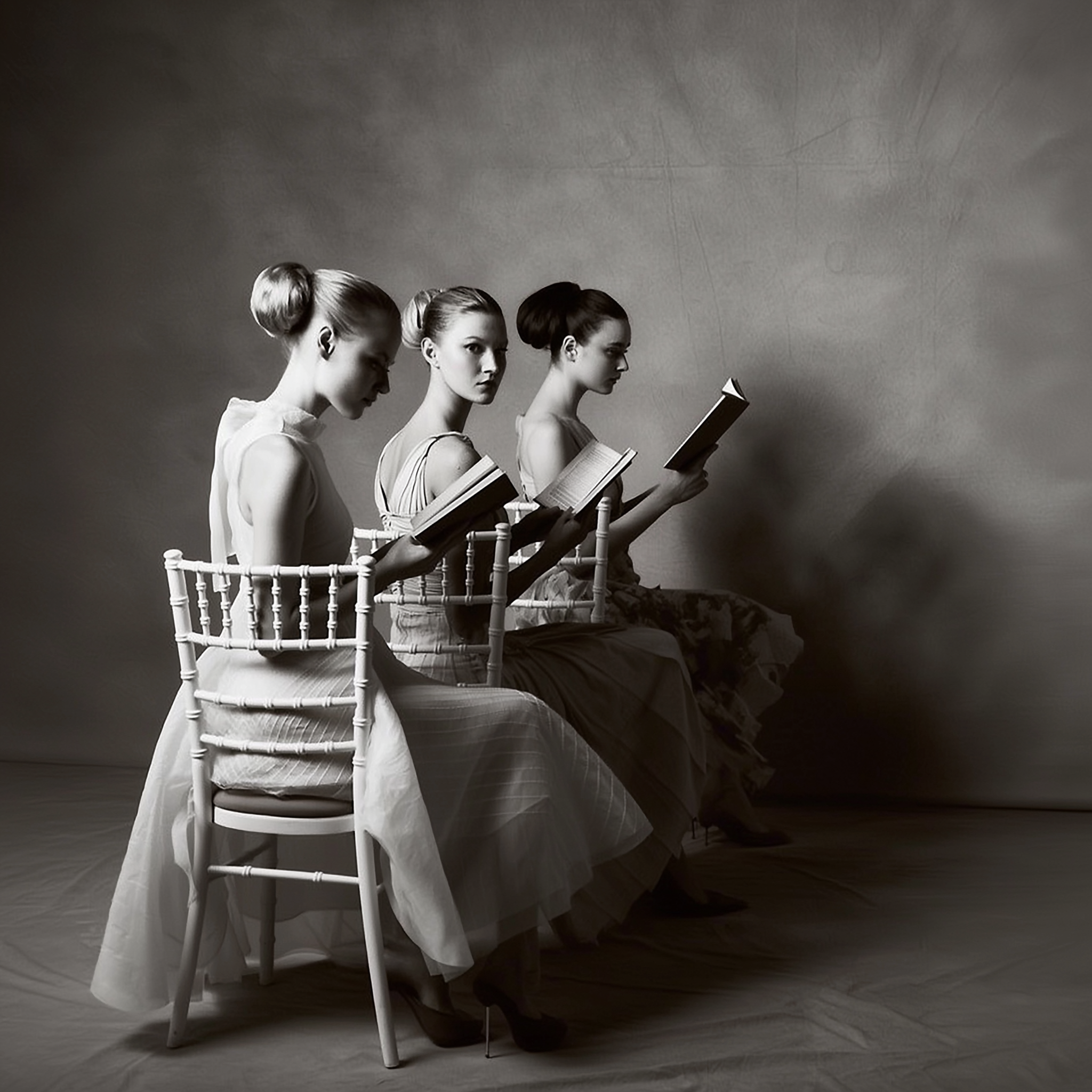
The Air Signs: The World in Our Heads
 The air signs—Gemini, Libra, and Aquarius—float through life like a trio of intellectual butterflies. These signs, blessed by the airy element, are less bound to earth and more inclined to chase the winds of inspiration, connection, and understanding. Governed by Mercury, Gemini is the embodiment of air in its most playful, changeable form. They’re the chatterboxes, flitting from idea to idea. Ruled by Venus, Libra is air distilled into elegance and equilibrium. These are the souls of compromise, forever balancing the ladies of justice and beauty. They seek harmony not just outwardly, but inwardly, where their endless contemplation often blooms into wisdom about the nature of connection and cooperation. Under the ruler of Uranus (and Saturn in traditional astrology), Aquarius embodies air in its most revolutionary and altruistic form. These are the skywatchers, the innovators, the eccentric dreamers who peer beyond the horizon of possibility. Aquarius is the air sign that turns intellectualism into activism, uniting thought with action in the service of humanity. Their ideas, though sometimes unconventional, are the seeds of transformation.
The air signs—Gemini, Libra, and Aquarius—float through life like a trio of intellectual butterflies. These signs, blessed by the airy element, are less bound to earth and more inclined to chase the winds of inspiration, connection, and understanding. Governed by Mercury, Gemini is the embodiment of air in its most playful, changeable form. They’re the chatterboxes, flitting from idea to idea. Ruled by Venus, Libra is air distilled into elegance and equilibrium. These are the souls of compromise, forever balancing the ladies of justice and beauty. They seek harmony not just outwardly, but inwardly, where their endless contemplation often blooms into wisdom about the nature of connection and cooperation. Under the ruler of Uranus (and Saturn in traditional astrology), Aquarius embodies air in its most revolutionary and altruistic form. These are the skywatchers, the innovators, the eccentric dreamers who peer beyond the horizon of possibility. Aquarius is the air sign that turns intellectualism into activism, uniting thought with action in the service of humanity. Their ideas, though sometimes unconventional, are the seeds of transformation.
Air is what makes us more than beasts; it’s the capacity to reason, to communicate, to dream of things that never were. Gemini can talk the moon out of the sky, Libra can mediate between it and the tides, and Aquarius will have a blueprint to colonize it before the conversation is even over. These signs teach us that while the world can be heavy, there is a buoyancy to existence—a way to float above the chaos and see the bigger picture. They are not the airy dreamers of possibility, showing us that with a little imagination, even the most grounded among us might soar.
The Breath of Life
The breath of life—air. It’s the unseen, unifying force, the invisible connection between all living things. The essence of air isn’t just about breathing; it’s about being connected—not in some banal, surface-level sense, but in the profound realization that we are all inhaling the same mystery, exhaling the same wonder.
Air, as the messenger of connection, doesn’t care for barriers. It flows freely, carrying stories, ideas, laughter, even the occasional awkward silence when words falter but presence remains. It’s there in every discussion that spirals into something deeper, every group activity where strangers discover what brings them together.
Think of how air transcends the boundaries of time and culture. It is the great equalizer, reminding us that no matter how diverse our backgrounds, we’re all the same. And let’s not forget the beauty of air’s impermanence. You can’t hold it or hoard it; it exists only in the moment, as fleeting as a breeze that tousles your hair or a word that sparks a smile. Air brings us together—not just physically, as we sit in the same room or under the same sky, but emotionally, intellectually, and spiritually. It’s the medium through which we shoot the breeze, but also the force that reminds us we’re all part of something bigger, something shared, something that cannot be owned but only experienced. Breath by breath, word by word, air keeps us alive—not just in body, but in spirit.
The Fine Art of Engagement
The air signs are forever fluttering through the web of human interaction, poking their noses (and sometimes their entire beings) into the lives of others. But, let’s be honest, where would we be without their meddling? Connection is their bread and butter, and their meddling isn’t nosy—it’s the fine art of engagement, the act of bringing people together, whether they like it or not.
Their essence is all about relationships, not in the heavy, grounded sense of duty, but in the playful, dynamic dance of ideas and connections. To the air signs, the world is a grand social experiment, and every conversation is another strand in the ever-expanding web of human interaction. They’re not satisfied with silence; they crave the spark of dialogue, the buzz of exchanging thoughts and feelings, whether in person or through a thousand different mediums.
The mediums! Leave it to the air signs to innovate communication itself. Where there’s a need to express, to convey, or to connect, they’re already one step ahead. The invention of airmail? Surely inspired by an air sign—someone who looked at the vast sky and thought, “What if we could send letters through that?” Computers and email? The very embodiment of air’s principle: fast, free-flowing, and endlessly adaptive. Even the humble act of note-taking—the jotting down of ideas on flimsy paper—is an ode to the air signs’ need to capture the ephemeral and share it with the world. But it’s more than just tools and tech; it’s their relentless fascination with the lives of others. Air signs don’t just communicate; they connect. They’re curious about your story, your dreams, your fears. They want to know what makes you tick, not because they’re prying, but because they see relationships as mirrors, reflecting back the infinite complexity of existence. They communicate because they care, and because they believe there’s always something worth discovering in the meeting of two minds.
In their world, life isn’t meant to be lived in isolation; it’s a conversation, a ceaseless exchange of thoughts, ideas, and feelings. And whether they’re scribbling on paper, typing out emails, or engaging in a spirited debate, air signs show us of the beauty of connection—the truth that we are never truly alone as long as we have words, curiosity, and the willingness to engage with one another.
Th Way Ideas Evolve
The air signs embody the way ideas evolve, and how a simple exchange of thoughts can spiral into something vast and world-shaping. Their domain is the realm of communication in all its glorious scales, from the intimate to the infinite. In Gemini, we see the spark of dialogue, the birth of connection. It’s the playful chatter with your neighbor, the inquisitive question asked to a friend, the quicksilver exchange of thoughts that feels as natural as breathing. Gemini’s approach is light and nimble—curious but not yet committed. It’s the first step, the initial pulse of conversation that reminds us we’re not alone in our thoughts.
Then comes Libra, the diplomat of discourse, where that lively dialogue takes on depth and deliberation. Libra listens as much as it speaks, weighing every word, and every thought. This is where communication becomes an art, where points of view are balanced and harmony is sought. A conversation with Libra is less about winning and more about understanding—a difference perspectives, always striving for that elusive equilibrium.
And finally, we soar into the realm of Aquarius, where communication transcends the personal and spills into the universal. Aquarius takes what began as a neighborly chat and transforms it into a global symposium, a collective exchange of theories, ideals, and revolutionary ideas. Here, the lines of contact are no longer confined to a circle of friends or a local community; they stretch across borders, cultures, and time. Aquarius isn’t just talking; it’s broadcasting, connecting humanity through a shared vision of progress and possibility.
The airy trigon is a journey of connection, growing from the intimate to the expansive. Communication isn’t just about the words we speak, but the bridges we build, and the shared dreams we dare to articulate. Whether it’s a private heart-to-heart or a worldwide conference, the air signs teach us that every conversation, no matter how small, carries the potential to change the world.
The Cold Element
Aristotle, in his ancient wisdom, deemed air a cold element—not in a lifeless way, but in its detachment, its ability to remain unflustered. When air is at its zenith, it holds a mirror to the world, showing events as they truly are, free from distortion or bias. It doesn’t rush to judgment, nor does it succumb to the heat of passion or the weight of despair. Instead, it observes, it analyzes, it dissects. In the hands of the air element, decisions are not rash but reasoned, born from an ability to rise above the fray and view conflict with an eagle’s perspective—seeing the whole, not just the parts.
People imbued with air in their charts seem to carry this cerebral coolness as a second skin. They approach life with a mind honed for exploration, eager to understand and eager to solve. They’re the ones who can pause in the midst of turmoil, their thoughts razor-sharp, and say, “Let’s think this through.” It is the power of intellect, the gift of logic, and the beauty of ideas far removed form emotion’s whims.
Yet, while it may seem distant, it’s also immensely connective. It seeks to understand the self and the other, using its mind to bridge gaps, to mediate, to communicate. Air, in its essence, doesn’t drown you like water, scorch you like fire, or bury you like earth. Instead, it lifts you up, clears your vision, and gives you the space to breathe and think. It shows us the beauty of detachment—not as a withdrawal, but as a way of seeing things more clearly, of understanding without being overwhelmed.
Jungian Astrology
The airy realm as seen through Jungian astrology— is a world brimming with thinkers, dreamers, and the scribes of human experience. These are the ones who live not in the immediacy of instinct or the turbulence of emotion but in the lofty citadel of thought. Air, with its unyielding dedication to the thinking function, gives its children the gift of abstraction, the ability to step back and survey life from a vantage point of pure reason.
It’s no surprise, then, that those influenced by air gravitate toward roles that require the shaping of thought into form: reporters who write about current world events; scientists who unravel the mysteries of the universe with logic; authors and media workers who try to make sense of the human condition. They are the ones who can take the overwhelming, swirling chaos of existence and sequence it into something rational, something digestible, something we can all understand.
The air signs abstraction isn’t cold or lifeless—it’s imaginative, visionary. They don’t analyze systems; they dream of better ones. They imagine societies where justice isn’t just an idea but a practice, where communication flows freely and misunderstanding is a relic of the past. They are social thinkers, forever tinkering with the blueprint of humanity, drawing and redrawing lines in their minds, imagining what could be rather than settling for what is.
Their gift for social commentary comes from this same ability for detachment. They can look at the world and say, “This isn’t working; here’s how it could.” They’re not content with the status quo. Instead, they take their abstract musings and translate them into ideas that can reshape communities, systems, and, at their best, the very fabric of society. They may live in the mind, but their thoughts ripple outward, touching the lives of others through words, policies, inventions, or movements.
The Human Mind
The human mind is forever thrilled by the spark of unexpected insight, a sudden flash where understanding arrives fully formed, like lightning illuminating the dark. The thinking types are the ones charting the course of our civilization, their thoughts the engines of progress, their minds the scaffolding on which humanity’s ever-climbing ladder rests.
Every thought, every idea, is a little revolution. It’s the mind taking raw data—the chaos of reality—and processing it into something meaningful. This isn’t a routine task; it’s the alchemy of progress. Each calculation, hypothesis, and abstract theory builds upon the last, a great chain of understanding stretching back to the dawn of civilization. From the firelight flickering on cave walls to the glow of supercomputers, every leap we’ve made began with someone daring to think, to question, to imagine.
The joy of thinking isn’t only found in solving the problems of the moment, though thinking types excel in that domain. It’s the capacity to dream beyond the immediate, to envision not just what is but what could be. Thinking types excel in this space, where information becomes possibility, where data becomes the seed of invention. This is where the evolution of humanity takes place, not in the passage of time but in the flowering of ideas.
Civilization itself owes its very existence to this process! Every advance in technology, every breakthrough in science, every improvement in our social structures—they’re all the fruits of human thought. Whether it’s the invention of the wheel or the algorithm driving modern artificial intelligence, these strides are markers of the mind’s boundless potential to shape the world.
Yet, the beauty of this development lies in its collective nature. No thought exists in isolation; each is built on the work of countless others, spanning generations. This grand web of intellect, where the discoveries of one inspire the innovations of another, is the true essence of progress. It’s humanity in conversation with itself across time, constantly refining, improving, and aspiring.
Here we are, poised in a moment where technology and science offer unprecedented opportunities for advancement. The challenge now is to ensure these strides serve not just the few but the many, to use our collective intellect to uplift humanity as a whole. This is the great promise of thinking: that it creates a better world, one idea at a time. And in this, the thinking types are not just participants but pioneers, leading the way with minds forever sparked by the thrill of discovery.
The Intellectual Dreamers
The air signs are the intellectual dreamers and cerebrals who lift the veil of chaos to reveal order, vision, and progress. They are the essence of forward motion, the guiding winds of modernization, carrying humanity from one era of understanding to the next. Through their innate curiosity, their penchant for categorizing, and their tireless search for patterns, they are the ones who chart paths through the maze of human complexity.
It’s no small feat that the airy intellect has helped shape what we now call civilization. The act of thinking—really thinking—is a profound rebellion against stagnation. It’s a divine alchemy that turns information into solutions, breakthroughs, and, ultimately, liberation. Every technological advance, every leap in science, every shift toward equity and understanding—it all begins with someone daring to imagine a better way. And if that doesn’t have the fingerprints of air all over it, I don’t know what does.
The air signs thrive in this realm of possibility, delighting in puzzles and pondering the mechanics of the universe, whether it’s a mathematical theorem or the realms of human relationships. They do it to understand how things might work better. To them, the world is perpetually evolving as their imaginations rise to meet its challenges. And what is this if not the story of human progress itself? Slavery abolished, literacy spreading like wildfire, women standing shoulder to shoulder with men in all corners of society—these are the triumphs of collective thought, of ideas rising above ignorance. The air signs embody this spirit, not content to solve problems but to dismantle the very structures that create them, replacing them with systems that liberate and elevate.
Modernisation is a product of imagination. It’s the ability to envision a world free from the chains of the past, whether those chains are ignorance, inequality, or fear. With every expansion of knowledge comes a new sense of emancipation, a feeling that we are, at last, breathing easier, freer, and fuller. The air signs show us of what is possible when we dare to think beyond the immediate, beyond the practical, and even beyond the probable. Their essence is in the pursuit of that divine design—a world that is not only functional but fair, not just advanced but enlightened. They are the breath that keeps humanity moving forward, a gentle gust toward a future that is forever brighter, smarter, and more just.
The Unity of Air
Dane Rudhyar observes that the air we breathe—an invisible essence moving ceaselessly across borders and barriers—is the ultimate democratizer. It laughs in the face of walls, scoffs at our notions of sovereignty, and quietly asserts a universal truth: we are all, inescapably, connected. Air, as Rudhyar so beautifully points out, is not only a physical necessity but an archetypal force, reminding us of the folly of division. No matter how high we build our towers of exclusivity, how fiercely we guard our little kingdoms of identity, we cannot escape the communal nature of breath itself.
Every arrogant isolationist, every narrow-minded zealot, inhales the same air as the person they might choose to ignore or despise. This is a humbling thought, is it not? That the very act of survival binds us to one another in ways we cannot sever. What’s more, air is a carrier—not just of oxygen, but of ideas, possibilities, and, sometimes, the consequences of our own folly. The pollutants we spew into it, whether literal or metaphorical, circulate just as freely as its life-giving essence. This dynamism, this ceaseless motion, mirrors the way ideas and energies move through humanity, linking us in ways both inspiring and challenging. Air doesn’t care for consent or preference; it simply is. And in its indifference lies its power—a force that connects, transforms, and transcends.
In the archetypal sense, air embodies the highest ideals of shared existence. It whispers of universality, of the inevitability that we are all part of one intricate, interdependent system. It’s a force that demands recognition of the other, not through coercion but through the quiet truth of interconnection. Even the most hardened heart cannot deny the reality of a shared breath, just as even the loftiest mind must acknowledge the commonality of thought’s raw materials.
Perhaps this is why air is so closely linked to the intellect and the abstract. It operates beyond the the visible and the measurable, challenging us to think beyond our tribal instincts and petty divisions. Air tells us that while we may define ourselves by our differences, the essence of life—the very act of breathing—proclaims something far greater: that we are, all of us, inextricably part of the same great, swirling dance of existence.
Heads in the Clouds
The air people live half in this world and half in the vast expanse of their own imaginations. Some accuse them of having their heads in the clouds, a remark that serves as both a criticism and a compliment. They dwell in the abstract, the ideal, and the possible. Their active minds, always spinning and dreaming, are the engines of innovation, understanding, and connection. Their over-idealism, the quixotic belief in what could be, is often misunderstood. It’s not naivety but a relentless commitment to an objective, rational perspective—one that seeks to rise above the muck and mire of emotion and look at the world as it is, and more importantly, as it might be.
This idealism is their hope, their attempt to engineer a better reality, not just for themselves but for all of us. And yet, for all their lofty musings, air signs are deeply tied to reality, though not in the way earth signs are. They govern the realm of experience and interaction, the act of stepping outside oneself to connect, to communicate, to engage with the vast realm of existence. What they perceive in their thoughts is an ongoing dialogue with the universe itself. Air signs live for what can be grasped, shared, and understood, even if they sometimes forget to land firmly on the ground.
Air signs do have their heads may be in the clouds, but those clouds hold the seeds of progress, of vision, of the interconnectedness that binds us all. Life isn’t only about what we can touch and hold but about the ideas that lift us, the interactions that expand us, and the dreams that sustain us. Their world may seem airy, but it governs everything that makes us human: the exchange of thoughts, the pursuit of knowledge, and the endless search to make sense of it all.
Light and Invisible
Air is the most elusive of the elements, as pure and untouchable as a dream, yet the very foundation of our collective brilliance. Light and invisible, it dances through our lives, unnoticed until it’s absent or stirred into a whirlwind of ideas, conversations, and connections. It is the lifeblood of thought and the breath of inspiration, driving both the winds of the earth and the currents of the mind.
Air is the midwife of our society’s eternal longing—the desire to know, to question, to create. This hunger gives birth to marvels: the concepts, questions, and intellectual frameworks that define civilizations. Every great exam of life, whether in philosophy, science, or art, begins with air—a thought, a query, an idea spinning into existence like the first breath of dawn.
Air’s purity lies in its detachment. Unlike the weight of earth or the heat of fire, it carries no inherent bias, no agenda. It is light, free, and expansive. Without air, there would be no questions to ask, no tests of intellect, no spark of realization when the pieces finally fit together.
Human Understanding
The air signs are the consummate observers, the collectors of details, the rulers of human understanding. They have a way of seeing the world that is untouched by the haze of emotion. Their extraordinary insight turns even the simplest exchanges—be it a piece of gossip, a witty quip, or a hypothesis—into something meaningful, something illuminating. Gossip, chit-chat, and the seemingly trivial? For the air signs, they’re tools. Tools for gathering information, for weighing and sifting through opposing points of view, for decoding the nature of human behavior. Every word, every idea, every exchange is part of a larger puzzle they’re constantly piecing together.
Air signs can also be perfectionists! It’s not the kind that nitpicks at details for the sake of control but the kind that dreams of worlds so magnificent, so exquisitely ordered, that they seem to hover just beyond the realm of possibility. Air signs, with their high ideals and lofty thoughts, dare to conjure visions of the future that others might dismiss as impossible. They imagine systems where fairness reigns, where progress knows no bounds, where humanity rises to its fullest potential.
They are, in many ways, the essence of what we call “humanity.” It is through their endless curiosity, their need to understand and categorize, that the very essence of society is preserved and refined. Every theory they propose, every plan they make, is in service of something greater: the future betterment of the collective. Air signs improve the world, one idea, one plan, one dazzling revelation at a time.
What It Means to Be Human
From the tiniest details of human interaction to the vast, unknowable questions of existence, they are always delving, always probing, always searching for the essence of what it means to be human. It’s this ability to rise above the fray, to detach from the emotional storms that buffet others, that makes air signs so invaluable. When the rest of us are drowning in feelings, caught in the heat of the moment, it’s the air signs who step back, observe, and say, “Let’s think this through.” Their insights are like cool, clean gusts cutting through the fog of emotion—a breath of fresh air. They have a way of lifting the weight from a situation, offering perspectives that are clear, rational, and often startlingly innovative.
Their fascination with human nature, observed from a distance, is both their gift and their quirk. While others may throw themselves headlong into the chaos of connection, air signs prefer to linger on the outskirts, watching, analyzing, and turning their observations into a greater understanding. They’re like scientists of the soul, studying the behaviors and emotions of others with a detached curiosity, all while quietly shaping their own ideas about how to improve the human condition.
Air signs are not uninterested in emotions—they’re just not ruled by them. They see the bigger picture, the systems at play, and how small changes might create ripples of transformation. Through their clear insights and universal curiosity, they pave the way for a brighter, more thoughtful future. They are, quite literally, the winds of change, always moving, always refreshing, always telling us to look up, breathe deep, and imagine what might come next.
Liz Greene says:
The ancient symbol for man is the pentagram of a five pointed star, and the number 5 has always been associated with Mercury, the significator of the mind. Following this line of thought, we can see a correlation with the fact that five divided into the circle of three hundred and sixty degrees yields the quintile of seventy-two degrees, one which is associated with skill and the possession of an unusual mental capacity – the province of Mercury who was an androgynous figure in mythology. All of these associations help to illuminate the nature of the airy trigon. The Astrology of Relating
This quotation also beautifully summarizes the air signs in motion:
“For them, the earliest condition of men resembled that of the beasts, and from this primitive and miserable condition they laboriously reached the existing state of civilisation, not by external guidance or as a consequence of some initial design, but simply by the exercise of human intelligence throughout a long period.”







 Venus-Pluto Synastry: A Love So Powerful That It Might Just Kill Them
Venus-Pluto Synastry: A Love So Powerful That It Might Just Kill Them
 Uranus Transits 8th the House: Rebirth from Chaos
Uranus Transits 8th the House: Rebirth from Chaos
 Mars Conjunct Pluto Synastry
Mars Conjunct Pluto Synastry
 Uranus Transits: 1st House: Winds of Change:
Uranus Transits: 1st House: Winds of Change:
 Sun Conjunct Pluto Synastry: Enlightening or Annihilating
Sun Conjunct Pluto Synastry: Enlightening or Annihilating
 Venus Conjunct Pluto Natal Aspect
Venus Conjunct Pluto Natal Aspect
 Uranus in the 2nd House: The Price of Freedom
Uranus in the 2nd House: The Price of Freedom
 Uranus Transits the 4th House: The Chaotic Path to Personal Inner Growth
Uranus Transits the 4th House: The Chaotic Path to Personal Inner Growth
 Transiting Uranus Trines Mercury: Through New Eyes
Transiting Uranus Trines Mercury: Through New Eyes
 Flash Forward: How Uranus Reveals Your Future Before You’re Ready
Flash Forward: How Uranus Reveals Your Future Before You’re Ready
 Uranus Transits Mars: My Eco-Lifestyle Changes
Uranus Transits Mars: My Eco-Lifestyle Changes
 Mercury in the 9th House: The Mystic Messenger
Mercury in the 9th House: The Mystic Messenger
 Scorpio’s Cold Withdrawal
Scorpio’s Cold Withdrawal
 The Neptunian: Highs, Heartache, and the Water Slide of Disclosure
The Neptunian: Highs, Heartache, and the Water Slide of Disclosure
 Uranus Transits Mars: My Carbon Footprint Intervention
Uranus Transits Mars: My Carbon Footprint Intervention
 Sun Square Pluto Synastry: You’ve Got That Power Over Me
Sun Square Pluto Synastry: You’ve Got That Power Over Me
 Venus Trine Pluto: Dark Desires
Venus Trine Pluto: Dark Desires
 Mars in the 12th House: Are You a Passive Victim of Weird Energies?
Mars in the 12th House: Are You a Passive Victim of Weird Energies?
 Saturn Square Pluto Natal Aspect
Saturn Square Pluto Natal Aspect
 Pluto in Aquarius: Collective Welfare
Pluto in Aquarius: Collective Welfare